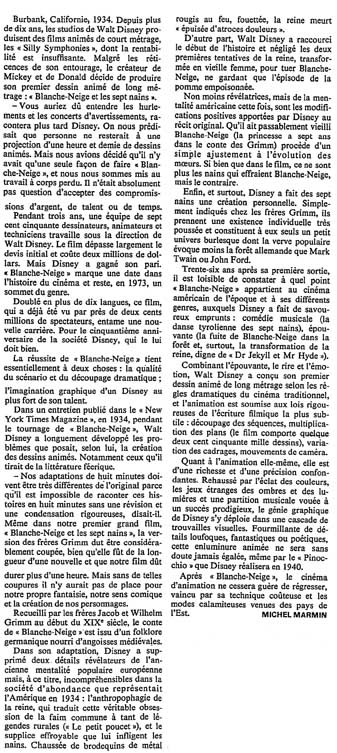
Founded in 1966 by Raymond Bourgine, Valeurs Actuelles was a French magazine focused on stock market information before becoming a far-right opinion newspaper, which is still published today. From 1966 to 1972, film criticism was provided by the anti-Semitic writer Lucien Rebatet under his usual pseudonym, François Vinneuil. However, it was his successor, Michel Marmin, who published the review of Snow White and the Seven Dwarfs during the film’s re-release in France in 1973. He held the position until 1978, when he took on the same role at Le Figaro.
Untitled article
by Michel Marmin (December 3, 1973)
Burbank, California, 1934. For more than ten years, Walt Disney’s studios have been producing animated short films, the “Silly Symphonies,” which have proven unprofitable. Despite the reluctance of those around him, the creator of Mickey and Donald decides to produce his first full-length animated film: Snow White and the Seven Dwarfs.
— You should have heard the screams and the warnings, Disney would later recount. People predicted no one would sit through an hour and a half of animated films. But we had decided that there was only one way to make Snow White, and we threw ourselves into it wholeheartedly. There was absolutely no question of accepting any compromises.
For three years, a team of seven hundred and fifty animators, designers, and technicians worked under the direction of Walt Disney. The film far exceeded its original budget and cost two million dollars. But Disney won his bet. Snow White marks a turning point in the history of cinema and remains, in 1973, a pinnacle of the genre.
Dubbed in more than ten languages, this film, which has already been seen by nearly two hundred million spectators, embarks on a new career for the fiftieth anniversary of the Disney company, which owes much to the film.
The success of Snow White essentially rests on two things: the quality of the screenplay and dramatic structuring; the graphic imagination of Disney at the height of his talent.
In an interview published in the New York Times in 1934, during the filming of Snow White, Walt Disney elaborated on the problems he faced, as he saw it, in the creation of animated films. Particularly, those he drew from fairy tale literature.
— Our adaptations of eight minutes must be very different from the original because it’s impossible to tell these stories in eight minutes without a revision and rigorous condensation, he said. Even in our first major film, Snow White and the Seven Dwarfs, the version of the Grimm brothers had to be considerably cut down, although it was the length of a novella, and our film had to last over an hour. But without such cuts, there would be no room for our own fantasy, our comic sense, and the creation of our characters.
Collected by the brothers Jacob and Wilhelm Grimm in the early 19th century, the story of Snow White comes from German folklore steeped in medieval anxieties.
In his adaptation, Disney removed two details that revealed the old popular European mentality but, in this context, were incomprehensible in the society of abundance represented by America in 1934: the anthropophagy of the queen, which translates into a true obsession with hunger common to many rural legends (“Hop-o’-My-Thumb”), and the gruesome torture of the one who puts his red-hot hands into the fire, whipped, the queen dies “exhausted from excruciating pain.”
On the other hand, Walt Disney shortened the beginning of the story and overlooked the two earlier attempts of the queen, transformed into an old woman, to kill Snow White, keeping only the episode with the poisoned apple.
No less revealing, but this time of the American mentality, are the positive changes Disney made to the original story. The fact that he somewhat aged Snow White (the princess is seven years old in the Grimm tale) was simply an adjustment to the evolution of manners. So much so that in the film, it’s no longer the dwarfs who frighten Snow White, but the reverse.
Finally, and most importantly, Disney made the seven dwarfs a personal creation. Simply indicated by the Grimm brothers, they are given a very individual existence and make up, on their own, a small burlesque universe whose popular spirit evokes less the German forest than Mark Twain or John Ford.
Thirty-six years after its first release, it is evident how Snow White belongs to the American cinema of the time and to its various genres, which Disney drew from with great success: musical comedy (the Tyrolean dance of the seven dwarfs), horror (the flight of Snow White in the forest and, above all, the transformation of the queen, worthy of Dr. Jekyll and Mr. Hyde).
Combining horror, laughter, and emotion, Walt Disney designed his first full-length animated film according to the rules of traditional cinema, and animation is subject to the rigorous laws of the most subtle cinematic writing: sequence breakdown, multiplication of shots (the film contains about two hundred and fifty thousand drawings), variation in framing, and camera movement.
As for the animation itself, it is of an overwhelming richness and precision. Enhanced by the brilliance of colors, the strange play of shadows and lights, and a musical score destined for prodigious success, Disney’s graphic genius unfolds in a cascade of visual discoveries. Teeming with whimsical, fantastic, or poetic details, this animated illuminature will likely never be matched, not even by Pinocchio which Disney would create in 1940. After Snow White, animated cinema will hardly stop regressing, defeated by its expensive technique and the disastrous trends from Eastern countries.

